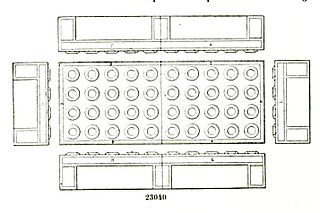The 18th century BC was the century that lasted from 1800 BC to 1701 BC.
The 1720s BC was a decade lasting from January 1, 1729 BC to December 31, 1720 BC.

Babylonia was an ancient Akkadian-speaking state and cultural area based in the city of Babylon in central-southern Mesopotamia. It emerged as an Akkadian populated but Amorite-ruled state c. 1894 BC. During the reign of Hammurabi and afterwards, Babylonia was retrospectively called "the country of Akkad", a deliberate archaism in reference to the previous glory of the Akkadian Empire. It was often involved in rivalry with the older ethno-linguistically related state of Assyria in the north of Mesopotamia and Elam to the east in Ancient Iran. Babylonia briefly became the major power in the region after Hammurabi created a short-lived empire, succeeding the earlier Akkadian Empire, Third Dynasty of Ur, and Old Assyrian Empire. The Babylonian Empire rapidly fell apart after the death of Hammurabi and reverted to a small kingdom centered around the city of Babylon.
The 1780s BC was a decade lasting from January 1, 1789 BC to December 31, 1780 BC.

The Old Babylonian Empire, or First Babylonian Empire, is dated to c. 1894–1595 BC, and comes after the end of Sumerian power with the destruction of the Third Dynasty of Ur, and the subsequent Isin-Larsa period. The chronology of the first dynasty of Babylonia is debated; there is a Babylonian King List A and also a Babylonian King List B, with generally longer regnal lengths. In this chronology, the regnal years of List A are used due to their wide usage.

Sin-Muballit was the father of Hammurabi and the fifth Amorite king of the first dynasty of Babylonia, reigning c. 1813-1792 or 1748-1729 BC. He ruled over a relatively new and minor kingdom; however, he was the first ruler of Babylon to actually declare himself king of the city, and the first to expand the territory ruled by the city, and his son greatly expanded the Babylonian kingdom into the short lived Babylonian Empire.
The 1760s BC was a decade lasting from January 1, 1769 BC to December 31, 1760 BC.

Samsu-iluna was the seventh king of the founding Amorite dynasty of Babylon, ruling from 1749 BC to 1712 BC, or from 1686 to 1648 BC. He was the son and successor of Hammurabi by an unknown mother. His reign was marked by the violent uprisings of areas conquered by his father and the abandonment of several important cities.
Ishme-Dagan I was a monarch of Ekallatum and Assur during the Old Assyrian period. The much later Assyrian King List (AKL) credits Ishme-Dagan I with a reign of forty years; however, it is now known from a limmu-list of eponyms unearthed at Kanesh in 2003 that his reign in Assur lasted eleven years. According to the AKL, Ishme-Dagan I was the son and successor of Shamshi-Adad I. Also according to the AKL, Ishme-Dagan I was succeeded by his son Mut-Ashkur.

The history of Mesopotamia ranges from the earliest human occupation in the Paleolithic period up to Late antiquity. This history is pieced together from evidence retrieved from archaeological excavations and, after the introduction of writing in the late 4th millennium BC, an increasing amount of historical sources. While in the Paleolithic and early Neolithic periods only parts of Upper Mesopotamia were occupied, the southern alluvium was settled during the late Neolithic period. Mesopotamia has been home to many of the oldest major civilizations, entering history from the Early Bronze Age, for which reason it is often called a cradle of civilization.

Seankhibre Ameny Antef Amenemhat VI was an Egyptian pharaoh of the early Thirteenth Dynasty.
Iufni was an ancient Egyptian pharaoh of the 13th Dynasty during the Second Intermediate Period.
'Damiq-ilīšu, was the 15th and final king of Isin. He succeeded his father Sîn-māgir and reigned for 23 years. Some variant king lists provide a shorter reign, but it is thought that these were under preparation during his rule. He was defeated first by Sîn-muballiṭ of Babylon and then later by Rīm-Sîn I of Larsa.
Yarim-Lim I, also given as Yarimlim, was the second king of the ancient Amorite kingdom of Yamhad in modern-day Aleppo, Syria.

The timeline of ancient Assyria can be broken down into three main eras: the Old Assyrian period, Middle Assyrian Empire, and Neo-Assyrian Empire. Modern scholars typically also recognize an Early period preceding the Old Assyrian period and a post-imperial period succeeding the Neo-Assyrian period.

Ibal pi’el II was a king of the city kingdom of Eshnunna in ancient Mesopotamia. He reigned c. 1779–1765 BC).

Rim-Sîn I ruled the ancient Near East city-state of Larsa from 1758 BC to 1699 BC or 1822 BC to 1763 BC. His sister En-ane-du was high priestess of the moon god in Ur. Rim-Sin I was a contemporary of Hammurabi of Babylon and Irdanene of Uruk. He was of Elamite descent, notwithstanding his Akkadian name.









